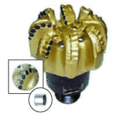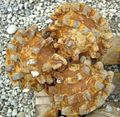- Well drilling
-
Well drilling is the process of drilling a hole in the ground for the extraction of a natural resource such as ground water, natural gas, or petroleum. Drilling for the exploration of the nature of the material underground (for instance in search of metallic ore) is best described as borehole drilling, or 'drilling'.
The earliest wells were water wells, shallow pits dug by hand in regions where the water table approached the surface, usually with masonry or wooden walls lining the interior to prevent collapse. Modern drilling techniques utilize long drill shafts, producing holes much narrower and deeper than could be produced by digging.
Well drilling can be done either manually or mechanically and the nature of required equipment varies from extremely simple and cheap to very sophisticated.
Managed Pressure Drilling (MPD) is defined by the International Association of Drilling Contractors (IADC) as “an adaptive drilling process used to more precisely control the annular pressure profile throughout the wellbore." The objectives of MPD are “to ascertain the downhole pressure environment limits and to manage the annular hydraulic pressure profile accordingly."
Drill bits in mechanical drilling
There are several factors that affect drill bit selection. Due to the high number of wells that have been drilled, using information from an adjacent well is most often used to make the appropriate selection. Two different types of drill bits exist: fixed cutter and roller cone. A fixed cutter bit is one where there are no moving parts, but drilling occurs due to percussion or rotation of the drill string. Fixed cutter bits can be either polycrystalline diamond compact (PDC) or grit hotpressed inserts (GHI). Roller cone bits can be either tungsten carbide inserts (TCI) or milled tooth (MT). The manufacturing process and composites used in each type of drill bit make them ideal for specific drilling situations. Additional enhancements can be made to any bit to increase the effectiveness for almost any drilling situation.
A major factor in drill bit selection is the type of formation that needs to be drilled. The effectiveness of a drill bit varies by formation type. There are three types of formations: soft, medium and hard. A soft formation includes unconsolidated sands, clays, soft limestones, red beds and shale. Medium formations include calcites, dolomites, limestones, and hard shale. Hard formations include hard shale, calcites, mudstones, cherty lime stones and hard and abrasive formations.
The first roller cone patent was for the rotary rock bit and was issued to Howard Hughes Sr. in 1909. It consisted of two interlocking cones. Walter Benona Sharp worked very closely with Hughes in developing the rock bit. The success of this bit led to the founding of the Sharp-Hughes Tool Company.
In 1933 two Hughes engineers, one of whom was Ralph Neuhaus, invented the tricone bit, which has three cones. The Hughes patent for the tricone bit lasted until 1951, after which time other companies started making similar bits. However, Hughes’ market share was still 40% of the world's drill bit market in 2000. The superior wear performance of PDC bits gradually eroded the dominance of roller cone bits and early in this century PDC drill bit revenues overtook those of roller cone bits.
The technology of both bit types has advanced significantly to provide improved durability and rate of penetration of the rock. This has been driven by the economics of the industry, and by the change from the empirical approach of Hughes in the 1930s, to modern day domain Finite Element codes for both the hydraulic and cutter placement software.
In 2011 market shares were divided between Hughes Christensen, Smith Bits (recently acquired by Schlumberger), REEDHycalog (acquired by NOV in 2008), Security-DBS (now Halliburton Drill Bits and Services) HDBS, and smaller companies such as Drilformance, VIPER BITS, Encore PDC Bits, DOWDCO, Varel, TSK, PDC Logis, Focusrocbit, Sam(AOE), Walker-Mcdonald et al., Ulterra [1], Lone Star Drill Bits, and Shear Bits Ltd. making up the rest.
-
Mud log in process, a common way to study the lithology when drilling oil wells
Evaluation of the dull bit grading is done by a uniform system promoted by the International Association of Drilling Contractors (IADC). See Society of Petroleum Engineers / IADC Papers SPE 23938 & 23940. See also PDC Bits
See also
- Drilling rig
- Driller (oil)
- Drag bit
- Deep well drilling
- Blowout (well drilling)
- Water well
- Underbalanced drilling
- Geolograph
- Drilling mud
Manual well drilling methods:
External links
- Drilling Equipment
- Drilling a Well by Automobile, Popular Science monthly, February 1919, Page 115-116, Scanned by Google Books: http://books.google.com/books?id=7igDAAAAMBAJ&pg=PT33
- Schlumberger Oilfield Glossary
- Oil and gas well drilling, US Department of Labor [2]
- Water Well Drilling Ireland [3]
Categories:- Drilling technology
- Water wells
Wikimedia Foundation. 2010.







